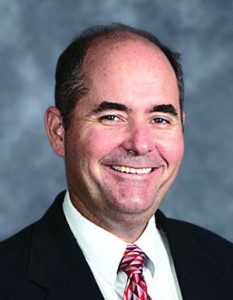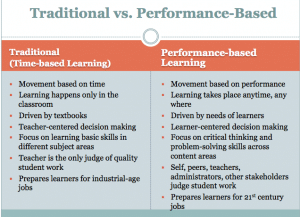Six Trends at Lindsay Unified School District
CompetencyWorks Blog

This is the first post in a series on Lindsay Unified School District. Read the second, third, fourth, and fifth posts here.
If your district is thinking seriously about converting to competency education, you should definitely bring a team to visit to Lindsay Unified School District. When I was last there, they had forty-plus educators from two districts in California, seven from Colorado, and one from Florida. You can register here for a site visit. (For funders out there – it’s worth considering figuring out how to do a virtual tour, as more people want to visit than Lindsay can accommodate and it’s expensive for districts to send a team. Just think how we could also reduce our carbon footprint if videos were available.)
One of the highlights of the visit was Superintendent Tom Rooney’s opening talk. I’ve known Tom for several years but have never heard him as sharp, urgent, and impassioned. After watching the video Transformational Learning (available in Spanish, as well), Rooney talked about graduation day as a great day for students. “This is a great day for educators, as well. We are saying to the world, ‘We’ve had them for twelve or thirteen years and we’re sending them out into society. They are our product, our contribution to society.’” He then continued, “The reality for many of our graduates is that they soon find out they didn’t get what they needed. Some of the kids fall into deep despair when they realize they have been betrayed. They were told that they are ready, but they’re not.”
Rooney then told a story that occurred when Virgel Hammonds was a new principal at Lindsay Unified High School (Hammonds is now the superintendent at RSU2 in Maine). It was late spring and Hammonds was just getting settled into his office, when in walked a father and his son who had graduated the week before. The father took a newspaper off the desk and gave it to his son, asking him to read it. After a few minutes of silence, the young man looked up with his tears in his eyes. “Dad, you know I don’t know how to read.”
Betrayal indeed. This is a betrayal that occurs all across our country.
Rooney wrapped up by saying, “We are handing out diplomas that say to students they are ready for life, and we know they aren’t. It’s not okay for young people to leave our system not ready for life. Nearly one hundred percent of our students are FRL. Parents are trusting us with their children. When they drop them off at the curb, they’re saying, ‘Give my son or daughter a chance in life. We are trusting you to break the cycle of poverty. Give them a chance.’” He continued, “We are done failing people – we are done failing educators, kids, parents, and society. We are taking the courageous steps forward. At Lindsay, educators and students are empowered and taking responsibility for learning. During your site visit, you won’t see perfection. You are going to see empowered learners and empowered learning facilitators who are committed to making things great for kids.”
Rooney then went on to describe Lindsay’s approach. It starts with their vision of learning: Every day, Lindsay learners come to school and are met at their developmental learning level; they are challenged, they are successful, and they leave school wanting to return tomorrow. He then showed a comparison of Lindsay’s performance-based system (PBS) with traditional education, pointing out, “The primary difference is that the traditional approach is about the adults, and performance-based learning is about the needs of the learners. We are dismantling the weight-bearing walls of the traditional system and replacing it with a learner-centered approach.”

There are substantial changes since I visited Lindsay a year ago (see this post for an overview of their design elements). Each one of these is so important they deserve an individual blog post, but a quick snapshot will have to do:
1) More Emphasis on Empowerment: Lindsay has embraced the tight/loose model. Outcomes are clearly defined, with empowered students working alongside empowered teachers to figure out how students will learn and demonstrate their learning. Transparency is at the core of this work. The graduation requirements of what students are expected to learn are transparent. Students, parents, and teachers can all look at the information system Educate (soon to be upgraded to Empower) to see exactly what students are learning, what defines proficiency, and where they are on the learning progressions across the disciplines. Teachers often raised the fact that they had permission to take risks and be more creative, as long as there were clear reasons why it would be helping students.
2) More Emphasis on the Why and Where Are You Going: I probably spoke with twenty-five or so students during the site visit, and each one talked about what they wanted to do after high school, even if it was to say that they were still exploring. When I asked about what learning targets they were focusing on, most (without prompts) could tell me why they were learning it and how it would be important to their lives. One student explained, “We can ask why we have to learn something. The answer isn’t because of state standards. It’s because what we are learning is important to us.”
Lindsay wants students to have a reason to go to college – not just because it’s the next step in education. They are doing so by expecting all students to have a career pathway (three consecutive courses) using the Linked Learning models to ensure rigorous academic content.
Although it’s not easy, they are also trying to bridge California’s A-G curriculum, which is designed to ensure students are prepared for entrance into the California university system. (Students have to take the A-G curriculum to be considered, even though it doesn’t guarantee you admission.) The rigor of the academic content is the same in the “college path” or the “career path” courses – the difference is that the college path has so many requirements, there are few opportunities for other electives. (Students have more electives in the career path.) Students who started in high school with weak foundational skills in math and reading may end up in the career path because they need to have more electives to build up their skills, even if they want to attend college in the future. Although students can move into from the career path to the college path, it requires being in school longer. However, California policy is not supportive of extended graduation rates, meaning that the district will be dinged if a student who transfers into Lindsay Unified High School with seventh grade skills needs to take a fifth year in order to seek admission to University of California.
3) More Emphasis on Lifelong Learning Standards: The team at LUSD has realized students aren’t going to achieve at high levels unless they have lifelong learning competencies (think habits of study, soft skills, or twenty-first century skills) in place. Brian Griffin, Assistant Principal at Lincoln School explained, “The academic piece is important, as is developing people who are empowered and can take responsibility, but the linchpin is intrinsic motivation. Without motivation, how are we going to have good learners and be globally responsible?” LUSD has been rapidly expanding their approach, building upon social-emotional learning that stretches from preschool through graduation. There is a rubric for each level so students understand that it is as important as math and history. Rebecca Midles, a Performance-Based Specialist explained, “For lifelong learning to be seen as important to students, social-emotional learning has to be equally valued, assessed, and reported out. It’s important to separate out behaviors and dispositions. It’s also important to honor them.”
4) Integrating Blended Learning: LUSD has a very clear structure and overall pedagogical approach within which the blended learning has been developed. In addition, the measurement topics and learning targets enable teachers to have a shared understanding of proficiency. The design of the blended learning is to help meet three challenges:
- To empower students so they have full access to the curriculum. (They already have full access to Educate to monitor their progress.)
- To increase the ability of students to work at a pace that is meaningful to them, including accessing curriculum above their grade level.
- To expand resources and choice available to support student learning, including adaptive software programs that can provide more intensive feedback and support for foundational skill building (recall and comprehension).
The backbone of LUSD is the performance-based structure with the online curriculum using the “flex model” to expand access and enhance the core values of their approach.
Assessing proficiency remains in the hands of teachers at LUSD. This is especially important as teachers may not know exactly how software programs are determining proficiency. LUSD is dedicating to upgrading their instruction and assessment to ensure that students are engaging in higher levels of rigor like analysis and knowledge utilization. (Lindsay uses the Marzano knowledge taxonomy.)
5) Increased Attention to Adult Learner Competencies: With their funds from Race to the Top, LUSD is investing in identifying the competencies that everyone – learning facilitators, principals, and school board members – involved in running a PBS school would need.
6) Leadership and Mutual Accountability: We all know it takes leadership to transform a school or district. Rooney told me that before they took one step down the road to performance-based systems, they first invested in the principal’s leadership capacity. As they advanced, they made sure they had a majority of educators ready to take the leap toward performance-based instruction. Yet there were still remnants of educators participating because they wanted to please their supervisors or because they had to.
There is now a much stronger sense of leadership among educators and a consistent mutual accountability between students and teachers. There is a strong sense of “we are in this together” as well as a strong sense of intrinsic motivation – the idea that everyone is doing their best, willing to take risks, and willing to learn because it is in the best interest of students.